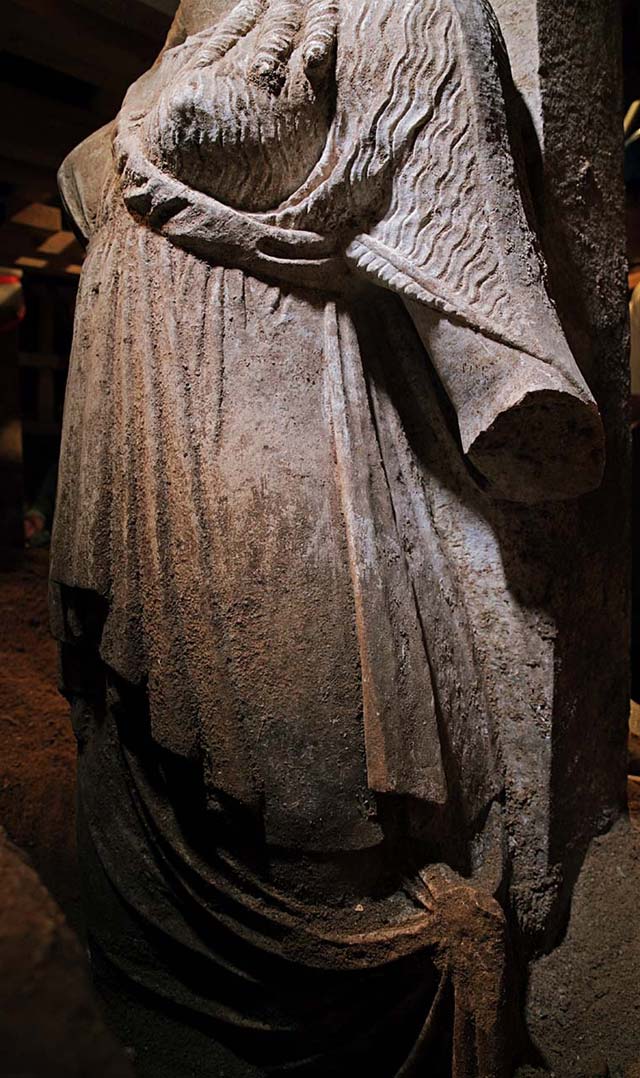Title photo and photo of the caryatids: Hellenic Ministry of Culture
Anastasia Balezdrova
The continuation of the chitons and the extremely skilfully cut shapes of the bodies of the two caryatids are the latest discovery of the archaeologists who are carrying out the excavations of Amphipolis tomb. Having removed the first stone block from the partition wall, they have found out that the sculptures do not support the architrave with their hands because they have found neither metal links nor traces of processing in its lower part. It however seems that the two beautiful female figures raise their hands from the outside of their chitons. The excavations at the particular place have also uncovered parts of the face and neck of the eastern caryatid.


The unique findings in Amphipolis every day provoke a variety of scenarios for the identity of the deceased laid in the tomb. In an interview for GRReporter professor of archaeology at the University of Thessaloniki Chrysoula Saatsoglou-Paliadeli said that more than one deceased might rest in it.
"The rich decoration including sculptures, as well as the extremely large size of the tomb and its courtyard clearly reflect the importance of the deceased person(s) as well as the capabilities of the people who undertook to pay honour to them."
 Her story about the historical period when the tomb was built explains why the region of Amphipolis was important for the Macedonian rulers, and especially for Alexander the Great.
Her story about the historical period when the tomb was built explains why the region of Amphipolis was important for the Macedonian rulers, and especially for Alexander the Great.
"The period from the death of Alexander in Babylon in 323 BC until the end of the 4th century BC was a very turbulent era marked by the disputes between his generals about who would succeed him, which led to the fragmentation of his empire. Amphipolis was an old colony of ancient Athens that Philip II subsequently conquered. The significance of the city was due to its vicinity with the Pangaea Mountains and the gold mines there, as well as to the port that played an important role in the expedition of Alexander. After his death, Aegae, the old capital of ancient Macedonia, started to gradually lose its importance, although the palace, the city and the cemetery continued to be used until their conquest by the Roman army in 168 BC and the final integration of the region into the composition of the Roman Empire in 148 BC."
The present name of the region where the ancient capital of the Macedonian kingdom was located is Vergina. Chrysoula Paliadeli was part of the team that carried out the excavations of the large mound, where they found the royal graves.
"Vergina is a huge archaeological site, which extends from the southern end of the Macedonian field at the northern foot of the Pierian Mountains and consists of a fortified city and the large mound cemetery, discovered and described by French archaeologist Léon Heuzey in 1876.
The area where the architectural site is located coincides with part of the "Macedonian land" of Herodotus, who defines its geographical position south of the Aliakmonas River. The period described by him precedes the establishment of the Macedonian kingdom in the 7th century BC. The large mound cemetery where Manolis Andronikos carried out excavations in the 1950s and 1960s belonged to this early period (1000 - 700 BC).
The excavations carried out by the Aristotle University of Thessaloniki from 1938 to the present day have uncovered, and continue to uncover, remarkable findings and inscriptions that give evidence of the royal presence in the region. They constantly affirm that the ancient capital of the Macedonian kingdom, Aegae, and the royal necropolis of the Temenidite dynasty (650-323 BC) were located precisely there, as was suggested by English historian Nicholas Hammond in 1968 for the first time.
The culmination of this research project was the excavations of the large mound that lasted from 1976 to 1980, with the discovery of royal tombs of Macedonian type that date back to the 4th century BC. Two of them were not desecrated by treasure hunters and, therefore, many precious objects were saved, including mural paintings of exceptional quality, which enhance our knowledge of ancient Greek art as a whole."

Chrysoula Paliadeli with Manolis Andronikos during the excavations of the Grand Mound in Vergina (1976 - 1980), Photo: personal archive
The course of the excavations at Amphipolis has so far revealed the presence of three partition walls erected by the ancient architect in order to prevent penetration into the tomb. The presence of the Lion of Amphipolis on top of the building and the statues discovered inside as well as their size distinguish it from the tombs that have been discovered in the region to date.
"The so-called Macedonian tomb is an underground monumental building covered with a semi-cylindrical roof (arch). It consists of one or more burial chambers, and the facade is designed and equipped with door openings reinforced with marble, and rarely with wooden, frames. This type of funerary architecture was established in Macedonia in the 4th century, initially for the needs of the royal burials. It is a distant descendant of the monumental dome tombs from the Mycenaean period that were created for the same purpose."
Since 2001, Professor Paliadeli has been in charge of the university excavations in Vergina, the course of which continues to unearth finds that are important for our knowledge of that historical period.